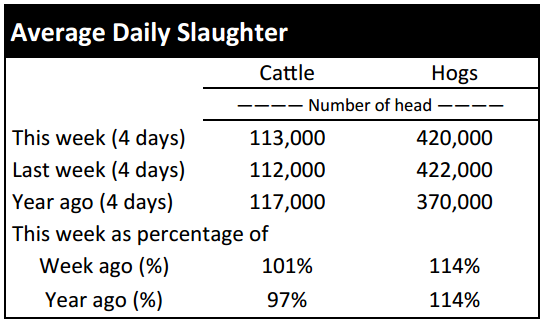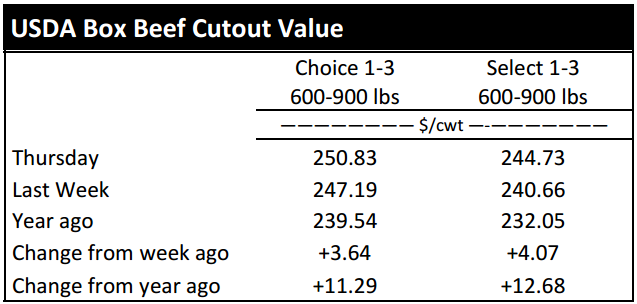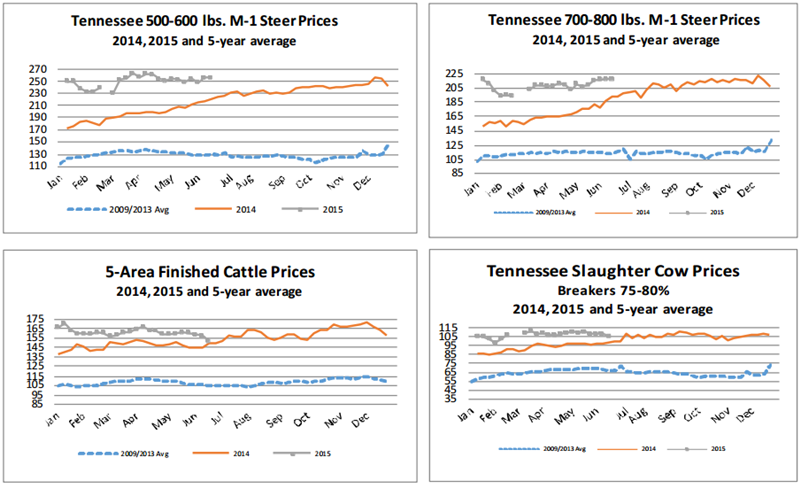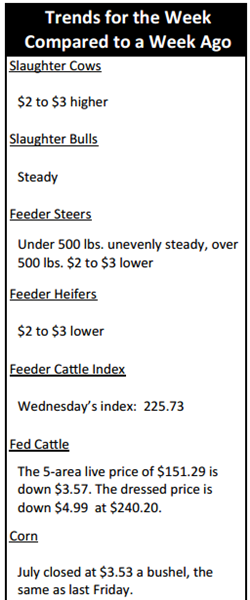Market Highlights: Beef Price Up, Cattle Down

Cattle prices fall, while beef prices improve.
By: Andrew P. Griffith, University of Tennessee
FED CATTLE: Fed cattle traded $4 lower on a live basis compared to a week ago. Live prices were mainly $150 to $152 while dressed trade was mainly $240. The 5-area weighted average prices thru Thursday were $151.29 live, down $3.57 from last week and $240.20 dressed, down $4.99 from a week ago. A year ago prices were $149.04 live and $236.94 dressed.
The seasonal summer slowdown continues to weigh on the fed cattle market as feedlot managers are being forced to market cattle at lower prices. These lower prices are definitely digging deep into the reserves as cattle feeding losses continue to mount.
The feeder cattle price is not declining nearly as quickly as the fed cattle price, and the deferred fed cattle price is not providing much of an opportunity to profit from today’s feeder cattle purchase if fed cattle prices do not make a positive move this fall. The one recourse feedlot managers have is to purchase calves at lower prices which seems to be tough since they are competing strongly against each other to secure cattle. They can also hope for lower feed costs, but feed costs are relatively low given the current corn market. Even a bumper corn crop is not going to reduce feed prices to make up for the buy-sell margin.
BEEF CUTOUT: At midday Friday, the Choice cutout was $250.84 up $0.01 from Thursday and up $3.70 from last Friday. The Select cutout was $245.79 up $1.06 from Thursday and up $4.49 from last Friday. The Choice Select spread was $5.05 compared to $5.84 a week ago.
Choice and Select cutout prices are somewhat disappointing considering June is generally the lead month for beef demand. It is also disappointing considering grilling holidays such as Father’s Day is this weekend and Independence Day is just around the corner. The retail sector has been slow to feature proteins this month with major slowdowns in beef and pork features.
Both pork and beef appear to be struggling from the export side of the market which increases downward pressure on the domestic price which can then feedback into the cattle production sectors. The beef export market was experiencing some record values one year ago, but the movement of items such as short plates and briskets has slowed tremendously.
Additionally, it has been difficult this year to move beef into markets that were considered growth markets last year. Some of the slowdown has been due to the price of beef but some of it has been due to policies in other countries.
Another policy that has yet to have its full impact is mandatory country of origin labeling which will slow trade with Canada and Mexico.
OUTLOOK: Steer and heifer calf prices lost a few dollars per hundredweight this week with larger losses coming on lighter weight calves. Calf prices have been able to maintain very well due to the anemic number of cattle available, but very few stocker producers are looking to take on much inventory during the heat of summer. Thus, calf prices are not expected to make a rally of any substantial significance in the near future and will likely find themselves losing a few dollars in future weeks.
Alternatively, it is unlikely for calf prices to be caught in a landslide and lose very many dollars because feedlots are looking for cattle to fill pens and there are a limited number available. The yearling market tends to be strong heading into the last of July through the first of September.
Yearling prices are expected to remain relatively strong heading through that time period again this year. However, producers in the western states and Plains states have been holding cattle for longer on grass which has delayed them entering the feedlot as well as increasing the weight of cattle entering the feedlot. If drought like conditions were to begin negatively impacting these areas, which is far from the case right now, then the market could see an influx of heavy feeder cattle which might depress the yearling price to some small degree.
There does not appear to be any reason to worry about a depressed price due to drought at this time. What does appear to be a more pressing matter for the feeder cattle industry is the decline in the price of live cattle. Feedlots are finding it difficult to hedge a positive margin with calves being purchased currently. This is not to say they will not experience a positive margin when those cattle come off feed in November or December, but it is to say the use of the futures market and contracting cattle is less than positive at this point.
The June cattle on feed report for feedlots with a 1000 head or more capacity indicated cattle and calves on feed as of June 1, 2015 totaled 10.56 million head, 0.6% higher than a year ago, while the pre-report estimate average had cattle on feed up 0.9%. May placements in feedlots totaled 1.71 million head, down 10.2% from a year ago with the pre-report estimate average expecting placements down 8.6%. May marketing’s totaled 1.71 million head down 8.3% from 2014 while the pre-report estimate expectation was down 8.4%. Placements on feed by weight: under 800 pounds down 19.2% and 800 pounds and over even with a year ago.
ASK ANDREW, TN THINK TANK: Middle Tennessee Martin brought forth a question concerning stocking rates for cattle on pasture. The answer is not completely straight forward due to several factors. Some of those factors include specie of grass, quality of the grass stand, pasture management strategies, soil fertility, size and class of cattle, supplemental feeding program, and a host of other factors. However, most people are looking for a more direct answer. Understanding that individual producer’s stocking rates can vary due to the aforementioned factors, for budgeting purposes, the Department of Agricultural and Resource Economics at the University of Tennessee uses 2 acres for a cow-calf pair and between a half and three-quarters of an acre per 500 pounds of stocker cattle. Stocking rate is extremely important in cattle production because feed costs can make up 50 to 60 percent of total costs in a cow-calf operation and the same for stocker operations when not considering the cost of purchasing the animal. If producers want to look at cattle budgets, they can be found on the on ourbudgets page.
Please send questions and comments to agriff14@utk.edu or send a letter to Andrew P. Griffith, University of Tennessee, 314B Morgan Hall, 2621 Morgan Circle, Knoxville, TN 37996.
FRIDAY’S FUTURES MARKET CLOSING PRICES: Friday’s closing prices were as follows: Live/fed cattle –June $151.90 1.48; August $150.68 1.33; October $153.25 1.45; Feeder cattle - August $223.43 1.50; September $221.48 1.20; October $219.48 1.00; November $217.90 1.05; July corn closed at $3.53 down $0.05 from Thursday.











